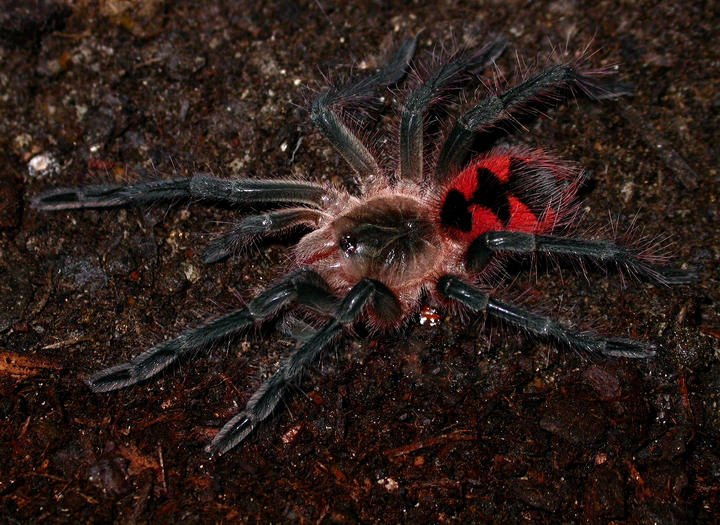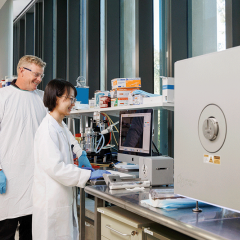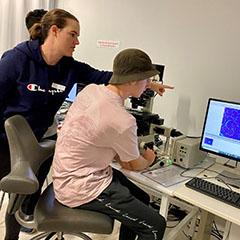Congratulations to CAI HDR students Gagan Sharma and James Humphries whose publications were selected as joint winners of Round 3 of the CAI 2020 HDR publication competition.
Sharma, Gagan; Deuis, Jennifer R; Jia, Xinying; Mueller, Alexander; Vetter, Irina; Mobli, Mehdi; "Recombinant production, bioconjugation and membrane binding studies of Pn3a, a selective NaV1.7 inhibitor" Biochemical pharmacology, 12 July 2020, pp.114148 doi: 10.1016/j.bcp.2020.114148

ABSTRACT: Chronic pain is a common and often debilitating condition. Existing treatments are either inefficacious or associated with a wide range of side effects. The progress on developing safer and more effective analgesics has been slow, in large part due to our limited understanding of the physiological mechanisms underlying pain in different diseases. Generation and propagation of action potentials is a central component of pain sensation and voltage-gated sodium channels (NaVs) play a critical role in this process. In particular, the NaV subtype 1.7, has emerged as a promising universal target for the treatment of pain.
Recently, a spider venom peptide, μ-TRTX-Pn3a, was found to be a highly selective inhibitor of NaV1.7. Here, we report the first recombinant expression method for Pn3a in a bacterial host, which provides an inexpensive route to production. Furthermore, we have developed a method for bio-conjugation of our recombinantly produced Pn3a via sortase A-mediated ligation, providing avenues for further pre-clinical development.
We demonstrate how heterologous expression in bacteria enables facile isotope labelling of Pn3a, which allowed us to study the membrane binding properties of the peptide by high-resolution solution-state nuclear magnetic resonance (NMR) spectroscopy using a recently developed lipid nanodisc system. The heteronuclear NMR data indicate that the C-terminal region of the peptide undergoes a conformational change upon lipid binding. The membrane binding properties of Pn3a are further validated using isothermal titration calorimetry (ITC), which revealed that Pn3a binds to zwitterionic planar lipid bilayers with thermodynamics that are largely driven by enthalpic contributions.
Image by www.universoaracnido.com - Own work, CC BY-SA 2.5, https://commons.wikimedia.org/w/index.php?curid=13600591
Humphries, James; Pizzi, David; Sonderegger, Stefan E; Fletcher, Nicholas L; Houston, Zachary H; Bell, Craig A; Kempe, Kristian; Thurecht, Kristofer J; "Hyperbranched Poly(2-oxazoline)s and Poly(ethylene glycol): A Structure−Activity Comparison of Biodistribution", Biomacromolecules (2020) 21(8), 3318-3331, DOI: 10.1021/acs.biomac.0c00765
ABSTRACT: In light of research reporting abnormal pharmacokinetic behavior for therapeutics and formulations containing poly(ethylene glycol) (PEG), a renewed emphasis has been placed on exploring alternative surrogate materials and tailoring specific materials to distinct nomedicine applications. Poly(2-oxazolines) (POx) have shown great promise in this regard; however, a comparison of POx and PEG interactions with components of the immune system is needed to inform on their distinct suitability. Herein, the interaction of isolated immune cells following injection of hyperbranched polymers comprised of PEG or hydrophilic Pox macromonomers was determined via flow cytometry. All materials showed similar association with all of the splenic immune cells analyzed. Interestingly, splenic CD68hi and CD11bhi macrophages showed similar levels of polymer association, despite CD11bhi being a smaller population, suggesting CD68 is linked to increased recognition and phagocytosis of these nanomaterials. This is of interest given that CD68 is a scavenger receptor and directly facilitates the clearance of cellular debris and promotion of phagocytosis, as opposed to CD11b, which is associated with the mediating inflammation via the production of cytokines as well as complement-mediated uptake of foreign particles. In the liver, PEG and poly(2-methyl oxazoline) hyperbranched polymers showed no discernible differences in their cellular association, while hyperbranched poly(2-ethyl oxazoline) showed increased association with dendrocytes and CD68hi macrophages, suggesting that this material exhibited a greater propensity to interact with components of the immune system. This work highlights the importance of how subtle changes in chemical structure can influence the immune response.



